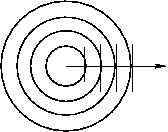Beam path

In seismics and seismology, the beam path (or path ) describes the path that a seismic wave travels through the earth from its place of origin to the place of its registration by a seismometer . It is the vertical trajectory of the wave front .
Earthquake or artificially excited seismic waves spread from the source location in all directions (see figure on the right). If the speed of propagation is the same in all directions, the propagation is spherical . At a great distance from the source, the wavefront appears to be flat due to the large radius, i.e. H. the curvature has become negligibly small. A plane wave is used here. The beam path is again perpendicular to the wave front.
Based on Fermat's principle , the energy propagation of a seismic wave runs through the earth's body on the path for which the time required between the source location and the location of the detection is minimal. If the propagation speed of the medium changes (e.g. due to a change in material, pore volume, pore filling, pressure change and much more), the jet path also changes. Since the speed inside the earth usually increases continuously ( gradually ) with depth, the beam paths of earthquake waves are mostly arc-shaped (figure, left).
The use of the beam path allows a simple geometric observation of the earthquake waves in the seismic investigation of the earth's interior, which in most cases provides sufficient accuracy. Complex underground structures, however, can lead to an incorrect evaluation if wave energy is scattered or reflected by structures outside the source-receiver plane . In such cases, a three-dimensional view of the subsurface is essential.
